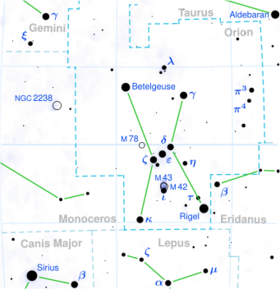Astronomy:HD 37756
| Observation data Equinox J2000.0]] (ICRS) | |
|---|---|
| Constellation | Orion |
| Right ascension | 05h 40m 50.71498s[1] |
| Declination | −01° 07′ 43.6366″[1] |
| Apparent magnitude (V) | 4.95[2] |
| Characteristics | |
| primary | |
| Spectral type | B2IV-V[3] or B3V[4] |
| U−B color index | −0.83[5] |
| B−V color index | −0.21[5] |
| secondary | |
| Spectral type | B1[6] |
| Astrometry | |
| Radial velocity (Rv) | +26.10[7] km/s |
| Proper motion (μ) | RA: −1.50[1] mas/yr Dec.: −0.84[1] mas/yr |
| Parallax (π) | 3.63 ± 0.37[1] mas |
| Distance | approx. 900 ly (approx. 280 pc) |
| Absolute magnitude (MV) | −2.74[2] |
| Orbit[8] | |
| Period (P) | 27.154925 d |
| Eccentricity (e) | 0.739±0.007 |
| Periastron epoch (T) | 2447886.076±0.065 HJD |
| Argument of periastron (ω) (secondary) | 81.4±2.4° |
| Semi-amplitude (K1) (primary) | 84.7±1.1 km/s |
| Details | |
| A | |
| Mass | 8.6±0.2[9] M☉ |
| Radius | 5.3[10] R☉ |
| Luminosity | 4,830[11] L☉ |
| Surface gravity (log g) | 3.84[10] cgs |
| Temperature | 21,150[11] K |
| Metallicity [Fe/H] | +0.01[12] dex |
| Rotational velocity (v sin i) | 75[13] km/s |
| Age | 18.0±3.2[9] Myr |
| B | |
| Mass | 8.3[6] M☉ |
| Other designations | |
| Database references | |
| SIMBAD | data |
HD 37756 is a binary star system in the equatorial constellation of Orion, positioned less than a degree to the north of the bright star Alnitak.[15] It has a blue-white hue and is faintly visible to the naked eye with an apparent visual magnitude of 4.95.[2] The system is located at a distance of approximately 900 light years from the Sun based on parallax,[1] and is drifting further away with a radial velocity of +26 km/s.[7] It is a member of the OB1b subgroup of the Orion OB1 association.[16]
The binary nature of this system was identified by E. B. Frost in 1904.[17] It is a double-lined spectroscopic binary with an orbital period of 27.15 days and a high eccentricity of 0.74.[8] The spectrum matches a massive B-type main-sequence star with a stellar classification of B3V.[4] The secondary is luminous enough to interfere with measurements of the primary spectrum.[17] It is a suspected Cepheid variable with a period of 0.37968 days and an amplitude of 0.03 magnitude in the B band of the UBV photometric system.[18] The system is a candidate eclipsing binary with a minimum dip of 0.04 in visual magnitude during each orbit.[19]
References
- ↑ 1.0 1.1 1.2 1.3 1.4 1.5 Van Leeuwen, F. (2007). "Validation of the new Hipparcos reduction". Astronomy and Astrophysics 474 (2): 653–664. doi:10.1051/0004-6361:20078357. Bibcode: 2007A&A...474..653V. Vizier catalog entry
- ↑ 2.0 2.1 2.2 Anderson, E.; Francis, Ch. (2012). "XHIP: An extended hipparcos compilation". Astronomy Letters 38 (5): 331. doi:10.1134/S1063773712050015. Bibcode: 2012AstL...38..331A. Vizier catalog entry
- ↑ Hoffleit, D.; Warren, W. H. (1995). "Bright Star Catalogue". VizieR On-line Data Catalog: V/50. Originally Published in: 1964BS....C......0H 5050. Bibcode: 1995yCat.5050....0H.
- ↑ 4.0 4.1 Houk, N.; Swift, C. (1999). "Michigan catalogue of two-dimensional spectral types for the HD Stars". Michigan Spectral Survey 5. Bibcode: 1999MSS...C05....0H.
- ↑ 5.0 5.1 Mallama, A. (2014). "Sloan Magnitudes for the Brightest Stars". The Journal of the American Association of Variable Star Observers 42 (2): 443. Bibcode: 2014JAVSO..42..443M.Vizier catalog entry
- ↑ 6.0 6.1 Kraicheva, Z.; Popova, E.; Tutukov, A.; Yungelson, L. (July 1980). "Catalogue of physical parameters of spectroscopic binary stars.". Bulletin d'Information du Centre de Donnees Stellaires 19: 71. ISSN 1169-8837. Bibcode: 1980BICDS..19...71K.
- ↑ 7.0 7.1 Wilson, R. E. (1953). "General Catalogue of Stellar Radial Velocities". Carnegie Institute Washington D.C. Publication (Carnegie Institution for Science). Bibcode: 1953GCRV..C......0W.
- ↑ 8.0 8.1 Hilditch, R. W. et al. (February 1991). "The eccentric-orbit binaries Iota Orionis and HD 1952: a cautionary tale". The Observatory 111: 14–20. Bibcode: 1991Obs...111...14H.
- ↑ 9.0 9.1 Tetzlaff, N. et al. (2011). "A catalogue of young runaway Hipparcos stars within 3 kpc from the Sun". Monthly Notices of the Royal Astronomical Society 410 (1): 190–200. doi:10.1111/j.1365-2966.2010.17434.x. Bibcode: 2011MNRAS.410..190T. Vizier catalog entry
- ↑ 10.0 10.1 McDonald, I.; Zijlstra, A. A.; Watson, R. A. (15 June 2017). "Fundamental parameters and infrared excesses of Tycho–Gaia stars". Monthly Notices of the Royal Astronomical Society 471 (1): 770–791. doi:10.1093/mnras/stx1433. ISSN 0035-8711. Bibcode: 2017MNRAS.471..770M.
- ↑ 11.0 11.1 Hohle, M. M. et al. (2010). "Masses and luminosities of O- and B-type stars and red supergiants". Astronomische Nachrichten 331 (4): 349. doi:10.1002/asna.200911355. Bibcode: 2010AN....331..349H. Vizier catalog entry
- ↑ Gontcharov, G. A. (2012). "Dependence of kinematics on the age of stars in the solar neighborhood". Astronomy Letters 38 (12): 771–782. doi:10.1134/S1063773712120031. Bibcode: 2012AstL...38..771G. Vizier catalog entry
- ↑ Abt, Helmut A. et al. (2002). "Rotational Velocities of B Stars". The Astrophysical Journal 573 (1): 359–365. doi:10.1086/340590. Bibcode: 2002ApJ...573..359A.
- ↑ "HD 37756". SIMBAD. Centre de données astronomiques de Strasbourg. http://simbad.u-strasbg.fr/simbad/sim-basic?Ident=HD+37756.
- ↑ Sinnott, Roger W.; Perryman, Michael A. C. (1997). Millennium Star Atlas. 1. Sky Publishing Corporation and the European Space Agency. p. 253. ISBN 0-933346-84-0.
- ↑ Voss, R. et al. (September 2010). "Probing the evolving massive star population in Orion with kinematic and radioactive tracers". Astronomy and Astrophysics 520: 10. doi:10.1051/0004-6361/201014408. A51. Bibcode: 2010A&A...520A..51V.
- ↑ 17.0 17.1 Rao, N. Kameswara et al. (1990). "The eccentric double-lined binary BD — 1° 1004". Journal of Astrophysics and Astronomy 11 (4): 445. doi:10.1007/BF02709760. Bibcode: 1990JApA...11..445K.
- ↑ Hill, Graham (August 1967). "On Beta Cephei Stars: a Search for Beta Cephei Stars". Astrophysical Journal Supplement 14: 263. doi:10.1086/190156. Bibcode: 1967ApJS...14..263H.
- ↑ Hoffleit, Dorrit (1996). "A Catalogue of Correlations Between Eclipsing Binaries and Other Categories of Double Stars". The Journal of the American Association of Variable Star Observers 24 (2): 105–116. Bibcode: 1996JAVSO..24..105H.
 |


